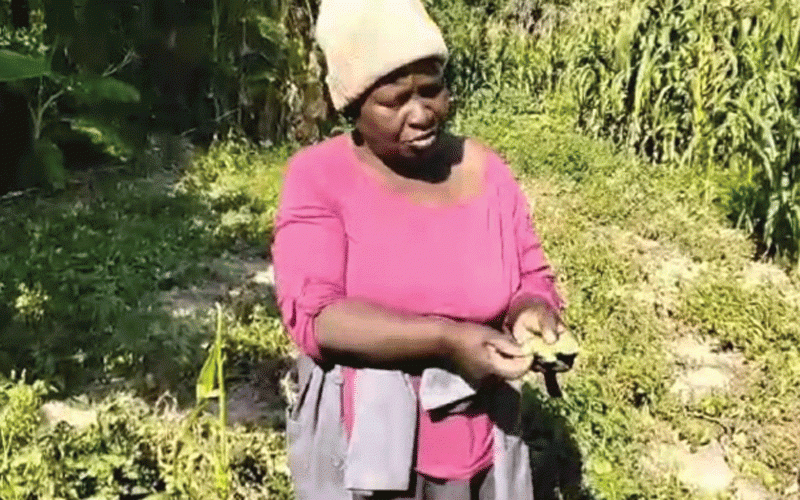
Villagers from Madzivazvido in Gokwe North, who have been relying for decades on selling tomatoes from their market gardens, are now bearing the brunt of climate change as rising temperatures and a proliferation of pests have resulted in reduced yields.
According to the United Nations Environment Programme, a UN agency responsible for coordinating responses to environmental issues, Zimbabwe’s temperatures have been rising over the years due to climate change.
The mean annual temperature in Zimbabwe increased by about 0.03°C per year from 1970 to 2016 and is expected to rise by 1 to 1.5°C by 2040. It could exceed 3°C by 2050, the UN agency recorded.
These rising temperatures have exacerbated the loss of wetlands, threatening agricultural productivity and livelihoods, especially for horticulture farmers.
They have also resulted in a proliferation of pests that attack the already reduced yields.
A report from the Food and Agriculture Organisation (FAO) says that wetlands contribute up to 20% of global agricultural production.
Farmers in Madzivazvido, located in a drought prone area in agro-ecological region 5, are, however, facing a different experience.
Their wetlands are shrinking and production, mainly of tomatoes, is declining.
- Irrigation panacea to droughts: Haritatos
- 60% of Zim has never known electricity
- Village Rhapsody: In Zimbabwe poverty is biting the poor the most
- Bantuman I introduces schools festival
Keep Reading
Natural Region 5 in Zimbabwe is characterised by low and erratic rainfall, making it the least suitable for crop production.
“We used to harvest 10 buckets a day, but these days we are harvesting five or less,”Agenia Murimira, a farmer from Kandowa village in Madzivazvido under Chief Chireya, told Truth Diggers.
“In the past we would deliver our tomatoes to Gokwe Centre and at some point, to Kwekwe, but these days our tomatoes are now for local consumption, especially at Chitekete business centre.”
This drop in production of tomatoes is not confined to Madzivazvido.
According to FAO, tomato production in Zimbabwe dropped from 26,6 kilotonnes in 2021, the highest tomato production on record, and 26,4kilotonnes the following year.
Zimbabwe currently imports 1.2 million metric tonnes of tomatoes every year.
Things are likely to get worse. The United Nations Environment Programme projects that rain-fed crop production in Africa will decline by 12% by 2080.
Farmers in Madzivazvido, with support from their local crop and livestock extension officers, are adopting strategies to mitigate the effects of climate change on tomato production.
“We are being encouraged to grow a variety of crops to boost soil health and are resilient to pests and diseases,” Murimira said.
Experts said planting crop varieties that are specifically bred or selected for their tolerance to heat, drought, pests, and diseases can improve yields in changing climatic conditions.
Climate change expert Peter Mangwanya said water is key in addressing the effects of climate change.
“In the face of climate driven water scarcity and stress, water harvesting and conservation technologies are fundamental,” he said.
“On top of that, we need improved disease and pest management technologies.”
He said greenhouse horticulture was key in producing high quality produce due to controlled temperature, light and water utilisation as it can promote sustainable agriculture in the face of climate change.
But this is not likely to benefit villagers from Madzivazvido because the cost of setting up greenhouses is too expensive for most villagers.
To make matters worse, besides the disappearing wetlands that have led to a drop in production of tomatoes, farmers in Madzivazvido are also facing another challenge caused by the rising temperatures - the proliferation of pests that attack their tomato crop.
Another climate change and natural resources expert Obrien Nhachi said generally, climate change favours the proliferation of pests leading to crop damage and reduced crop production.
“In most cases climate change results in an increase in the reproduction rates of pests and in Zimbabwe, warmer conditions result in the rise of pests like aphids and caterpillars, which damage crops such as cabbages and tomatoes,” he said.
“Altered rainfall patterns create conditions favourable for pests with waterlogged soils promoting fungal disease. Pests thrive in such conditions.”
Nhachi said climate change also causes pests to move to areas which they did not usually frequent thus widening the area and crop subject to attack.
Catherine Rusere (66) also from Madzivazvido, is one of the villagers fighting against the proliferation of pests.
“The weather patterns have drastically changed. It’s a little bit warmer these days which makes it conducive for pests particularly Tuta [TutaObsoluta], which has wreaked havoc on our tomato crop, to thrive,” Rusere said.
“This invasive pest has been troubling us over the years and we have been struggling to get rid of it. Look at the damage that the Tuta causes on the tomato plant’s leaves and stem,” she added, holding a tomato that had been attacked by the pest.
“It’s so aggressive that we are losing the battle and have cut our production.”
Obert Jiri, permanent secretary for the Ministry of Lands and Agriculture confirmed that climate change exacerbated the pest problem but he offered a solution.
“As climate change exacerbates the pest problem, there is a need for pest management strategies. These include monitoring climate changes and pest populations as well as adopting integrated pest management strategies,” he said.
But he admitted that local communities did not have the means to adopt these mitigatory measures because their ability to adapt pest management strategies depended on their physical, social and financial resources.
Most villagers just do not have the money as they are living from hand to mouth.
*This article was published under the Voluntary Media Council of Zimbabwe Investigative Journalism Fund with support from the Friedrich Naumann Foundation.
Truth Diggers is the investigative journalism arm of Alpha Media Holdings (AMH). AMH are publishers of The Standard, Zimbabwe Independent, NewsDay and Southern Eye as well as the proprietors of HSTV










